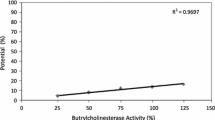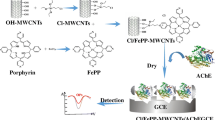Abstract
Due to their increasing use in agriculture, the presence of pesticide residues in food and water currently represents one of the major issues for the food safety. Among the pesticides, organophosphate and carbamate species are the most used, and their toxicity is mainly due to their inhibitory effect on acetylcholinesterase (AChE). For this reason, a monoenzymatic acetylcholinesterase impedimetric biosensor was developed in order to sensitively detect carbamate and organophosphate compounds with a very fast response. The working principle of the AChE biosensor exploits the capability of carbamate and organophosphate pesticides to form a stable complex with the enzyme, which causes an impedimetric change. The impedimetric biosensor showed a linearity between 5 and 170 ppb for carbamates and 2.5–170 ppb for organophosphate compounds, with a reproducibility (RSD%) interelectrode equal to 4.8 and 3.1% for organophosphates and carbamates, respectively. Moreover, the common amperometric evaluation of AChE inhibition degree was correlated to the impedimetric changes of the electrode surface, showing a good correlation (R 2 = 0.99 for carbamates and R 2 = 0.98 for organophosphates) between the two methods. In contrast to amperometric evaluation that needs a response time of 20 min, impedimetric detection requires only 4 min. Finally, the impedimetric biosensor was used to measure carbaryl and dichlorvos spiked in different concentrations in tap water and lettuce samples, showing a recovery near to 100% for all concentrations and for both pesticides.








Similar content being viewed by others
References
Albanese, D., Di Matteo, M., & Pilloton, R. (2012). Quantitative screening and resolution of carbamic and organoposphate pesticides mixture in extra virgin olive oil by acetylcholinesterase-choline oxidase sensor. J Environ Sci Eng A, 1, 68–77.
Andreescu, S., & Marty, J. L. (2006). Twenty years research in cholinesterase biosensors: from basic research to practical applications. Biomolecular Engineering, 23, 1–15.
Andreescu, S., Avramescu, A., Bala, C., Magear, V., & Marty, J. L. (2002). Detection of organophosphorus insecticides with immobilized acetylcholinesterase—comparative study of two enzyme sensors. Analytical and Bioanalytical Chemistry, 374, 39–45.
Arduini, F., Ricci, F., Tuta, C. S., Moscone, D., Amine, A., & Palleschi, G. (2006). Detection of carbamic and organophosphorus pesticides in water samples using cholinesterase biosensor based on Prussian Blue modified screen printed electrode. Analytica Chimica Acta, 580, 155–162.
Arduini, F., Guidone, S., Amine, A., Palleschi, G., & Moscone, D. (2013). Acetylcholinesterase biosensor based on self-assembled monolayer-modified gold-screen printed electrodes for organophosphorus insecticide detection. Sensors and Actuators B: Chemical, 179, 201–208.
Bahadir, E. B., & Sezginturk, M. K. (2016). A review on impedimetric biosensors. Artif Cells Nanomedicine Biotechnol, 44(1), 248–262.
Caetano, J., & Machado, A. S. (2008). Determination of carbaryl in tomato “in natura” using an amperometric biosensor based on the inhibition of acetylcholinesterase activity. Sensors and Actuators B, 129, 40–46.
Chauhan, N., & Pundir, C. S. (2011). An amperometric biosensor based on acetylcholinesterase immobilized onto iron oxide nanoparticles/multi-walled carbon nanotubes modified gold electrode for measurement of organophosphorus insecticides. Analytica Chimica Acta, 701, 66–74.
Colovic, M. B., Krstic, D. Z., Lazarevic-Pasti, T. D., Bondzic, A. M., & Vasic, V. M. (2013). Acetylcholinesterase inhibitors: pharmacology and toxicology. Current Neuropharmacology, 11, 315–335.
Darvesh, S., Darvesh, K. V., McDonald, R. S., Mataija, D., Walash, R., Mothana, S., Lockridge, O., & Martin, E. (2008). Carbamates with differential mechanism of inhibition toward acetylcholinesterase and butyrylcholinesterase. Journal of Medicinal Chemistry, 51, 4200–4212.
Fukuto, T. R. (1990). Mechanism of action of organophosphorus and carbamate insecticides. Environmental Health Perspectives, 87, 245–254.
Guan, J. G., Miao, Y. Q., & Zhang, Q. J. (2004). Impedimetric biosensors. Journal of Bioscience and Bioengineering, 97(4), 219–226.
Krstić, D. Z., Colovic, M., Kralj, M. B., Franko, M., Krinulovic, K., Trebse, P., & Vasic, V. (2008). Inhibition of AChE by malathion and some structurally similar compounds. Journal of Enzyme Inhibition and Medicinal Chemistry, 23, 562–573.
Liu, G., & Lin, Y. (2006). Biosensor based on self-assembling acetylcholinesterase on carbon nanotubes for flow injection/amperometric detection of organophosphate pesticides and nerve agents. Analytical Chemistry, 78, 835–843.
Malvano, F., ese, D., Pilloton, R., & Di Matteo, M. (2016). A highly sensitive impedimetric label free immunosensor for ochratoxin measurement in cocoa beans. Food Chemistry, 212, 688–694.
Mehta, J., Vinayak, P., Tuteja, S. K., Chhabra, V. A., Bhardwaj, N., Paul, A. K., Kim, K. H., & Deep, A. (2016). Biosensors and Bioelectronics, 83, 339–346.
Moscone, D., Volpe, G., Arduini, F., & Micheli, L. (2016). Rapid electrochemical screening methods for food safety and quality. Acta Imeko, 5, 45–50.
Sanllorente-Méndez, S., Domínguez-Renedo, O., & Arcos-Martínez, J. (2010). Immobilization of acetylcholinesterase on screen-printed electrodes. Application to the determination of arsenic(III). Sensors, 10, 2119–2128.
Sassolas, A., Prieto-Simon, B., & Marty, J. L. (2012). Biosensors for pesticide detection: new trends. American Journal of Analytical Chemistry, 3, 210–232.
Storm, J. E., Rozman, K. K., & Doull, J. (2000). Occupational exposure limits for 30 organophosphate pesticides based on inhibition of red blood cell acetylcholinesterase. Toxicology, 150, 1–29.
Vakurov, A., Simpson, C. E., Daly, C. L., Gibson, T. D., & Millner, P. A. (2004). Acetylcholinesterase-based biosensor electrodes for organophosphate pesticide detection: I. Modification of carbon surface for immobilization of acetylcholinesterase. Biosensors and Bioelectronics, 20(6), 1118–1125.
Valdes -Ramirez, G., Cortina, M., Ramirez Silva, M. T., & Marty, J. L. (2008). Acetylcholinesterase-based biosensors for quantification of carbofuran, carbaryl, methylparaoxon, and dichlorvos in 5% acetonitrile. Analytical and Bioanalytical Chemistry, 392, 699–707.
Xavier, M. P., Vallejo, B., Marazuela, M. D., Moreno-Bondi, M. C., Baldini, F., & Falai, A. (2000). Fiber optic monitoring of carbamate pesticides using porous glass with covalently bound chlorophenol red. Biosensors and Bioelectronics, 14, 895–905.
Author information
Authors and Affiliations
Corresponding author
Electronic supplementary material
ESM 1
(DOCX 1107 kb)
Rights and permissions
About this article
Cite this article
Malvano, F., Albanese, D., Pilloton, R. et al. A New Label-Free Impedimetric Affinity Sensor Based on Cholinesterases for Detection of Organophosphorous and Carbamic Pesticides in Food Samples: Impedimetric Versus Amperometric Detection. Food Bioprocess Technol 10, 1834–1843 (2017). https://doi.org/10.1007/s11947-017-1955-7
Received:
Accepted:
Published:
Issue Date:
DOI: https://doi.org/10.1007/s11947-017-1955-7




